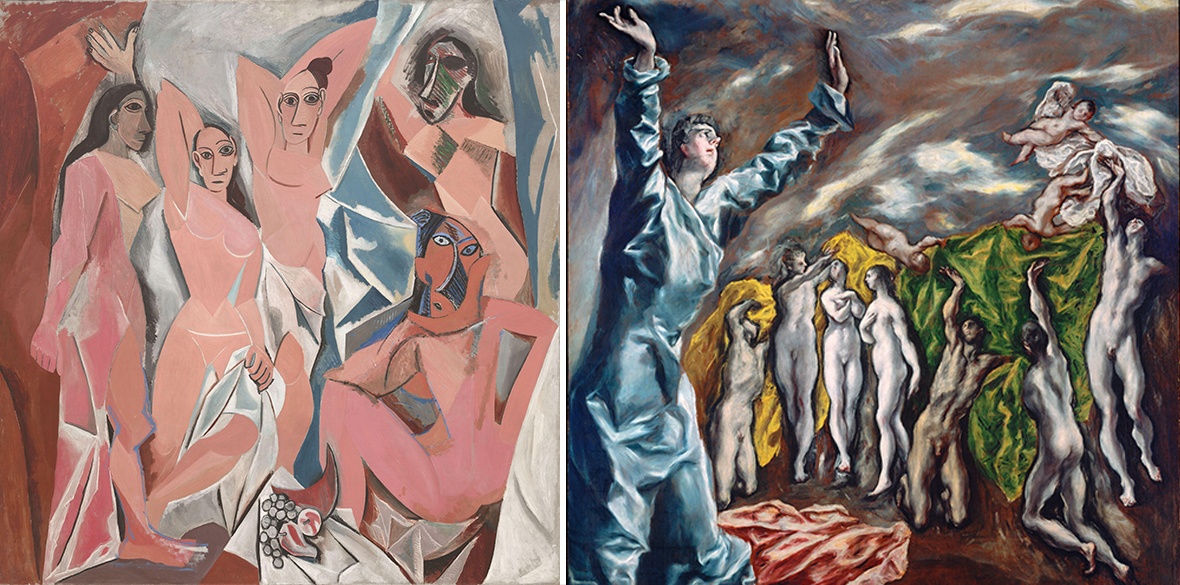This is the last article you can read this month
You can read more article this month
You can read more articles this month
Sorry your limit is up for this month
Reset on:
Please help support the Morning Star by subscribing here
PABLO PICASSO, an immigrant from Spain in Paris, was a 25 when he painted Les Demoiselles d’Avignon in 1907. The preparatory work took over six months and hundreds of sketches.
The Girls of Avignon, or Le Bordel d’Avignon, which was Picasso original title, depicts women of a brothel in Carrer d’Avinyo, a street in the Gothic quarter of Barcelona, where Picasso lived and which he was familiar with.
It was Picasso’s friend, the art critic Andre Salmon, who managed its first exhibition and, anticipating public outrage, renamed it Les Demoiselles d’Avignon.
The inspiration for the canvas would have come from a Paul Cezanne’s posthumous retrospective at the Salon d’Automne (Autumn Salon) of in 1906 — still on the annual Paris exhibitions’ calendar — when Picasso described the impact as: “Cezanne’s influence gradually flooded everything.”
Cezanne’s prismatic structuring of space and in particular his series of The Bathers appear to have made a significant impact on how young Picasso approached Les Demoiselles.
But Picasso was no imitator and the innovation and radicalism of the painting is contained in its composition, angular shapes, the absence of perspective, the compression of space and diverse facial characterisation.
For the first time the human figure is deidealised. The Renaissance tradition was unceremoniously done away with.
Picasso once said: “Good artists borrow, great artists steal” and nothing evidences that approach more than the semblance of the Demoiselles to the group of women in El Greco’s Opening of the Fifth Seal — while individually their physiognomies range from the Paul Gauguin-influenced figure on the left through the central two, which mimic his own Autoportrait of 1906, to the Ngi Mask of Gabon’s Fang peoples — he would have seen in the Musee d’Ethnographie du Trocadero.
Last is the “fragmented” destillation of form in the sitting figure which announces Picasso’s future formal direction.
The painting instantly wrong-footed the art world and its radicalism — of forms partially abstracted, flattened and fragmented, as if reflected in a shattered mirror vision — caused consternation and widespread hostility and even ridicule.
Such radical restructuring of the formal components of a painting had some furiously ragging and none more so than the deeply ofended Henri Matisse who called it “hideous whores” and believed Picasso was “taking the mickey.”
Others like Georges Braque — his future accomplice in developing Cubism — suggested Picasso had “drunk petroleum to spit fire onto the canvas,” while legendary art dealer Ambroise Vollard rushed in with: “It’s the work of a madman.”
Even the writer Gertrude Stein, Picasso’s fervent supporter, called it “a veritable cataclysm,” and Fauvist painter Andre Derain believed Picasso had gone too far.
A solitary recognition of the momentous significance of Les Demoiselles came from poet and future co-founder of Surrealism, Andre Breton, who sensed in it the starting point of a new epoch in painting.
But the controversy persisted for decades. The feminist critic Anna C Chave wrote: “The demoiselles appear not hideous or sickly to me, but plain and strong,” adding: “The demoiselles are thick-limbed, angular and broad-featured, [of] laborers’ stock.
“To my eye, the unmasked faces of the three figures on the left side of the picture suggest not syphilitic monsters but the glazed-over visages of hard-worn pros … the spectres of a society that no longer makes room for joy or love unless they can be bought and sold.”
In 1944 Picasso joined, like Breton before him, the French Communist Party observing that: “My joining the Communist Party is a logical step in my life, my work and gives them their meaning … I have become a communist because our party strives more than any other to know and to build the world, to make men clearer thinkers, more free and more happy.”












